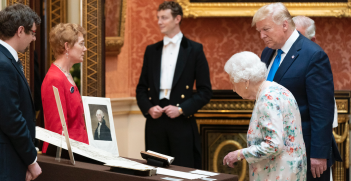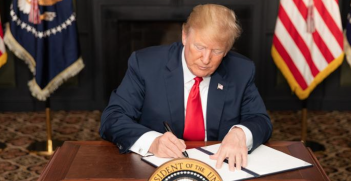The Lamps Are Going Out All Over North America: Canada and Trump 2.0

Donald Trump’s threatened tariffs on Canada signal a dramatic rupture in the decades-long economic and strategic partnership between the two countries, undermining trust and stability in North American trade. As Canada braces for potential economic retaliation, the broader message to US allies is clear—no relationship is immune from Trump’s zero-sum approach to global trade and diplomacy.
After months of threats, on 4 February 2025, President Donald Trump was set to impose a 25 percent tariff upon Canadian exports to the United States before a last minute deal led him to impose a thirty-day reprieve. Akin to the disastrous imposition of the Smoot-Hawley Tariff in 1930 in terms of scale, the tariffs likely would have devastated Canada’s economy: three-quarters of Canadian exports end up in the United States, with those exports equalling roughly 20 percent of Canada’s GDP. Little wonder, then, that the president’s threat has angered and alarmed many Canadians, some of whom took to booing the American national anthem at ice hockey games. With the thirty-day reprieve, Canadians have breathed a sigh of relief, but the new tariff deadline of 4 March looms, as does a Trump-ordered review of trade and tariff policy by US government agencies due 1 April 2025. In effect, Canada’s economy is being held hostage. This ongoing tariff threat comes after months of Trump jeering that Canada should join the US as the 51st state, an affront to Canadian sovereignty. That the Trump administration has targeted one of its country’s closest trading partners and trustworthy allies should serve as both a warning to other states that presume to have a special relationship with the Americans and a sign that Trump’s America is truly turning inwards.
As Canadian historians have long stressed, the American Revolution created two countries, the United States and what would become Canada. Despite later rosy rhetoric about an undefended border, the menace of American Manifest Destiny spurred Canadian nationalism and, often, an ugly strain of anti-Americanism that served as a potent political tonic for Canada’s politicians in the half-century or so that followed Canadian Confederation in 1867. The situation began to change in the mid-1930s: although the Smoot-Hawley Tariff had devastated cross-border trade and, with it, the Canadian economy, the election of Franklin Delano Roosevelt proved a turning point. In 1935, Roosevelt concluded a trade agreement with Canadian Prime Minister William Lyon Mackenzie King that rolled back tariffs on an array of products. With the clouds of war gathering elsewhere, the pursuit of friendly relations between a great power and a small one seemed especially notable.
When war did come, Roosevelt moved to bring Canada under America’s aegis, economically and militarily. The alliance forged by King and Roosevelt carried on into the Cold War era and beyond. So did an ever-increasing economic interdependence, marked by sectoral free trade in automotives in 1965 and then a wider free trade agreement in 1988—widened further with the North American Free Trade Agreement (NAFTA) in 1994. Relations during these many decades were not without periods of strain, but Canada broadly championed American global leadership and the countries developed a wide range of intergovernmental links to manage transnational issues, from the shared environment to criminal threats. Importantly, given the power imbalance between the two neighbours there was a sense that their dealings, as President Dwight Eisenhower once put it, were “an example that other nations someday surely will recognize and apply in their relationships.”
How far we are from the days when Americans would elect a figure like Eisenhower as opposed to a twice-impeached, convicted felon, serial bankruptee, and game show host. And how far we are from the notion of a special relationship between Canada and the United States. With the scratch of a black Sharpie, Trump has reversed eight decades of Canadian-American interdependence. While he has cited the flow of drugs and migrants across the border as the putative reasons for the tariffs (thereby linking Canada to Mexico and China, also targets of tariffs), his move is rooted in his long record of hostility to free trade going back to the 1980s. Campaigning vociferously against NAFTA throughout 2016, once in power Trump negotiated the Canada-US-Mexico Agreement (CUSMA). The tariffs he is threatening to impose stand in violation of CUSMA; like many of those who entered into business contracts with Trump, Canada has discovered that the president is far from trustworthy.
In order to potentially impose the tariffs, Trump has declared a border crisis; similarly, in his first administration, he labelled Canada a national security threat, thereby skirting NAFTA rules to tariff Canadian steel and aluminium. True, some illicit drugs and people do cross America’s northern border. But it is a tiny fraction of what crosses the US-Mexico border, and drugs, people, and firearms flow northward into Canada all without Ottawa sanctioning US trade. Canada was no more a national security threat to the United States in 2018 than it is now.
Given that Trump is a serial liar, one should not take his concern with the northern border at face value. Indeed, speaking just days ago, the president stated that there was nothing that Canada could have done to prevent the tariffs even as Ottawa rushed over a billion dollars into toughening the border. Importantly, Trump’s tariff threat singled out Canada, Mexico, and China, his country’s top three trade partners—and indeed a 10 percent tariff on China has gone ahead. One must see these tariffs as part of a long-term strategy by Trump and those around him to reshore manufacturing jobs to the United States while also using revenue collected through tariffs to pay for tax cuts. Then-candidate Trump outlined these goals throughout the 2024 election campaign, as did various officials who are now staffing or advising his administration. The move is a strategic blunder. While MAGA faithful are delighting that Trump is striking out at the American-led project of globalisation, Canada would be a natural economic partner for a United States looking close to home. Yet, the harsh reality is that, whether in terms of New York real estate or international trade, the president views economics as a zero-sum game. Up for a review in 2026, CUSMA seems fated to end up on the pyre of American autarky.
Ottawa’s threatened response to the tariffs—which may well have contributed to Trump’s volte-face—were premised on the bet that the impact of tariffs on American consumers and manufacturers, mixed with Canada’s countermeasures, would create enough economic and political pain to force Trump to back down. Even if this strategy were to work, the long-term impact of Trump’s threatened actions portends tough times ahead in Canada-US relations. In a speech delivered hours after the president’s tariff announcement, Prime Minister Justin Trudeau revealed Canada’s planned retaliatory measures and then spoke eloquently about the Canadian-American alliance, about common wartime sacrifices, and about the shared history between the two neighbours. Trump cares not for history. Nor does he care about the notion of being the leader of the free world. Going back to his first administration, Trump has consistently displayed deep antipathy for fellow democratic leaders—matched by a slavering affinity for authoritarian rulers. It remains to be seen what the president will do with regard to NATO, and what his appointment of similarly-minded conspiracists to positions throughout the US defence and national security apparatus will mean for joint defence efforts, intelligence-sharing arrangements, notably the Five Eyes, and the day-to-day work by Canadian and American law enforcement agencies to tackle transnational threats.
MAGA figures may speak about China as their biggest rival, but their actions toward their allies and friends, and the wider power vacuum being created by American retrenchment, is undermining any grand strategic effort aimed toward the Chinese. Canadians have noted that their exports to America were to incur a 25 percent tariff, yet China—a rival power—has been slapped with only a 10 percent tariff. And they do not take kindly to the president’s taunts that Canada become the 51st state. That suggestion, first shrugged off as a joke, now carries definite menace. For the first time in well over a century and a half, Canadians are confronting a president who is actively hostile to Canada and Canadian interests. Even if there does not end up being a North American trade war, any pretence of a special relationship between Canada and the United States is dead. And that should be a lesson to other American allies who have yet to face Trump again.
Asa McKercher is Steven K. Hudson Research Chair in Canada-US Relations and Associate Professor at the Mulroney Institute of Governance at St. Francis Xavier University, Canada. His books include Canada First, Nor Canada Alone: A History of Canadian Foreign Policy (Oxford, 2024) and Building a Special Relationship: Canada-US Relations in the Eisenhower Era, 1953-1961 (UBC Press, 2024).
This article is published under a Creative Commons License and may be republished with attribution.





